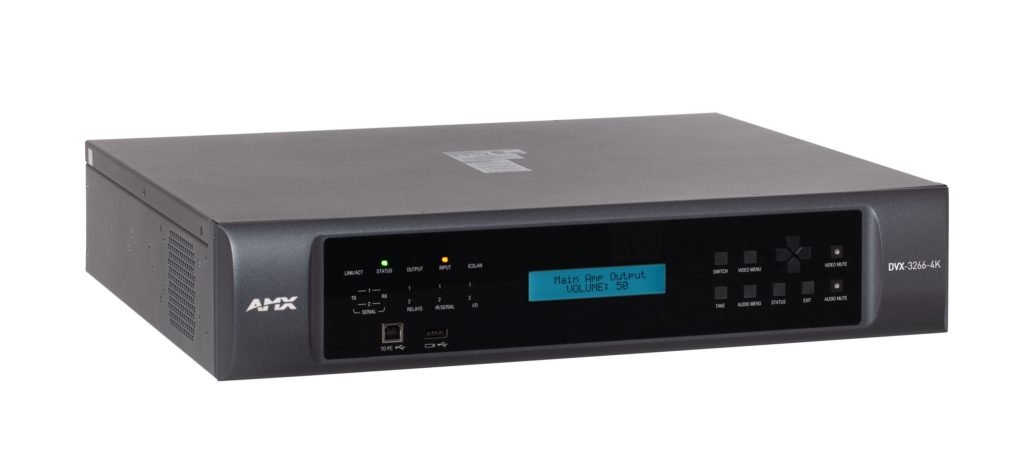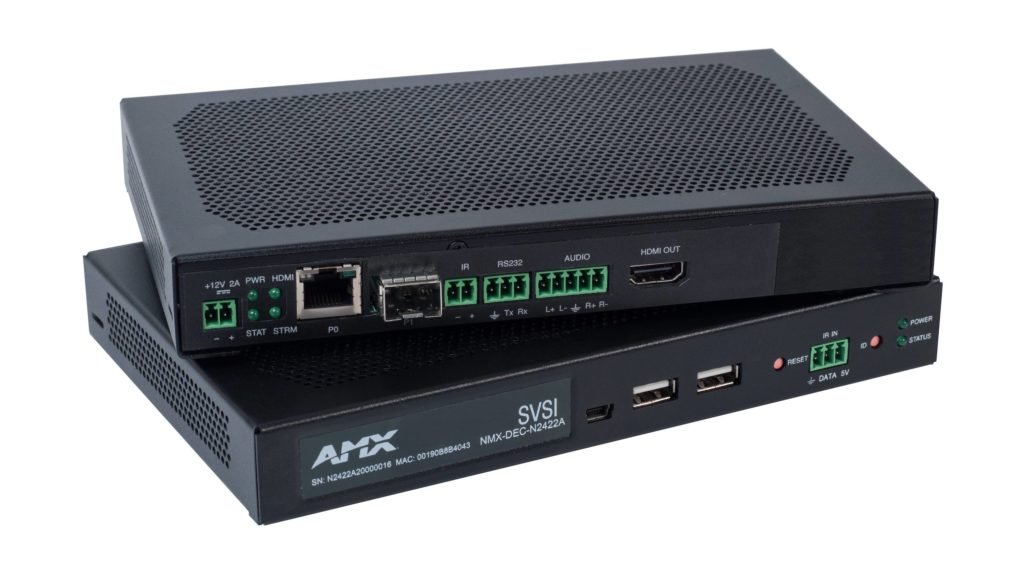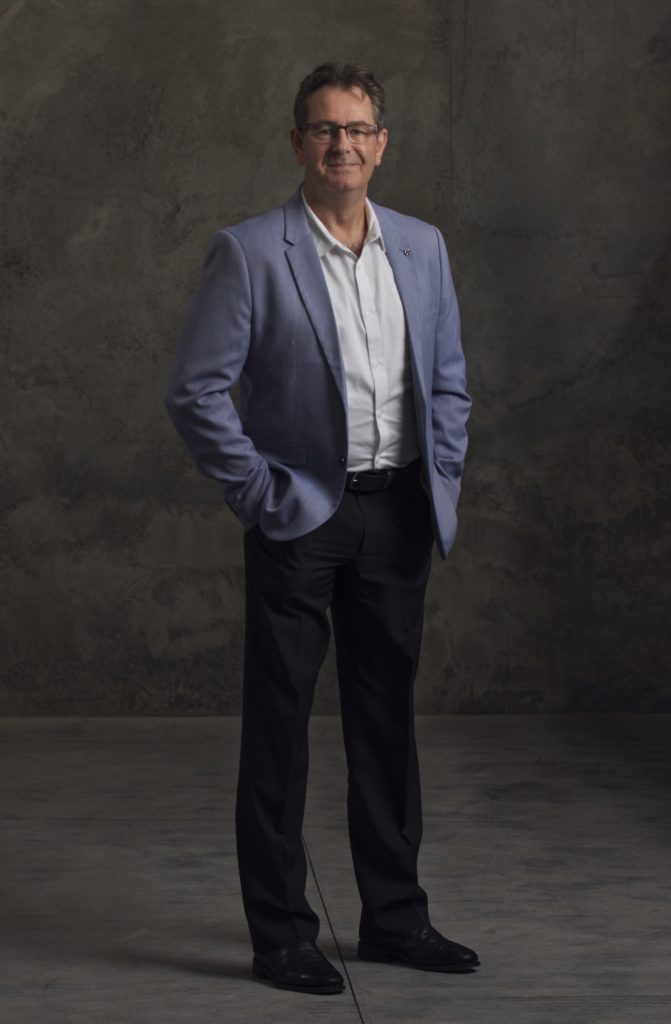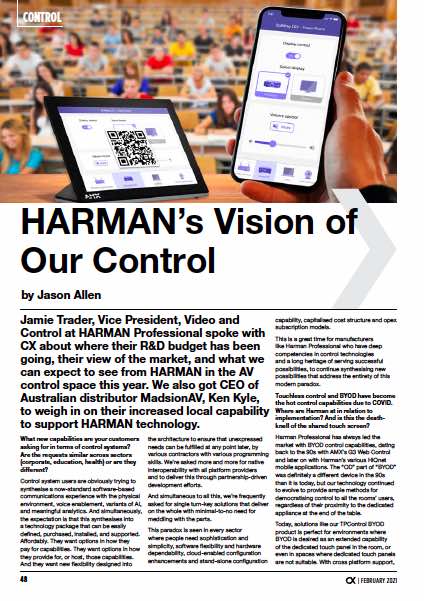Control
23 Feb 2021
HARMAN’s Vision of Our Control

Subscribe to CX E-News
Jamie Trader, Vice President, Video and Control at HARMAN Professional spoke with CX about where their R&D budget has been going, their view of the market, and what we can expect to see from HARMAN in the AV control space this year. We also got CEO of Australian distributor MadsionAV, Ken Kyle, to weigh in on their increased local capability to support HARMAN technology.
What new capabilities are your customers asking for in terms of control systems? Are the requests similar across sectors (corporate, education, health) or are they different?
Control system users are obviously trying to synthesise a now-standard software-based communications experience with the physical environment, voice enablement, variants of AI, and meaningful analytics. And simultaneously, the expectation is that this synthesises into a technology package that can be easily defined, purchased, installed, and supported.
Affordably. They want options in how they pay for capabilities. They want options in how they provide for, or host, those capabilities. And they want new flexibility designed into the architecture to ensure that unexpressed needs can be fulfilled at any point later, by various contractors with various programming skills.
We’re asked more and more for native interoperability with all platform providers and to deliver this through partnership-driven development efforts. And simultaneous to all this, we’re frequently asked for single turn-key solutions that deliver on the whole with minimal-to-no need for meddling with the parts.
This paradox is seen in every sector where people need sophistication and simplicity, software flexibility and hardware dependability, cloud-enabled configuration enhancements and stand-alone configuration capability, capitalised cost structure and opex subscription models.
This is a great time for manufacturers like Harman Professional who have deep competencies in control technologies and a long heritage of serving successful possibilities, to continue synthesising new possibilities that address the entirety of this modern paradox.

Touchless control and BYOD have become the hot control capabilities due to COVID. Where are Harman at in relation to implementation? And is this the death-knell of the shared touch screen?
Harman Professional has always led the market with BYOD control capabilities, dating back to the 90s with AMX’s G3 Web Control and later on with Harman’s various HiQnet mobile applications.
The “OD” part of “BYOD” was definitely a different device in the 90s than it is today, but our technology continued to evolve to provide ample methods for democratising control to all the rooms’ users, regardless of their proximity to the dedicated appliance at the end of the table.
Today, solutions like our TPControl BYOD product is perfect for environments where BYOD is desired as an extended capability of the dedicated touch panel in the room, or even in spaces where dedicated touch panels are not suitable.
With cross platform support, its simple for users to simply download the app, scan the QR Code, and users are up and running with a fully featured AMX control interface.
As we find more facilities bringing software-based communication platforms to the centre of their technology designs, like Zoom and Teams, we find the technology footprint dramatically decreasing. Some room’s capabilities won’t always demand the presence of dedicated touch interfaces, as the majority of the meeting technology is within the platform app itself.
With more and more customers choosing to leverage their existing fleet to run these apps, we recognise that fleet itself AS the device in BYOD. That is why we work with companies like Zoom to easily enable their ‘Room Controls’ interface to natively control AMX devices.
COVID is as much the death knell for the shared touch screen as it is for the light switch. It isn’t. There is always need and purpose for dedicated, always on, always available, touch interfaces. The question is more about which rooms deserve or demand them, and in what ways they might act as other sensory interfaces to add intelligence and simplicity to the room.
What particular areas has Harman been concentrating its R&D spend in? For example, we haven’t seen anything new out of BSS for a while – any news there?
Harman Professional has made significant investments in the entire R&D and operations organisations to design and manufacture the industry’s most comprehensive unified AVLC system.
An unparalleled effort in the marketplace, we’re unifying the underlying operating systems, control protocols, DSP framework, transport formats, and security architectures of our signature brands, whilst also pulling all of the configuration and management software used across those brands into one user-centric, work stream defined application suite.
This is in addition to the major investments we continue to make in our individual brand platforms. Waveforms, drivers, optics, light engines, compression algorithms, and more.
While the pandemic has been very economically challenging for everyone in our market, we’ve been fortunate to have the agility and financial strength to increase our R&D investments during this time.
This is a great time for manufacturers like Harman Professional who have deep competencies in control technologies and a long heritage of serving successful possibilities, to continue synthesising new possibilities that address the entirety of this modern paradox
The acceleration here compounding on the investments and energies over the past couple years is soon to produce the tangible results our dealers and end customers have come to expect from us.
As a wave of new products from all of our iconic brands, including AMX, BSS, Crown, Martin, and more begin to emerge, I’m confident we’ll both satisfy and surprise.We’re seeing more and more ‘green’ line items in budgets, like carbon costs and environmental impacts as a cost centre.
How would a new control system address this?
New control architectures emerge greener in several ways. On the product side, you’ll find an increased shift to software collocated on existing computing platforms and decreased power consumption on dedicated appliances.
But the real impact comes from the user application side, where you’ll find rooms leveraging control systems’ increased sensory technology to better synthesise environmental comfort with demand.
Tracking demand and fulfillment, reporting it, and enabling cost centre owners to quantify impact and savings in a meaningful way that results in agency rebates or discounts on energy performance.
Control systems have provided the capability to do these things for decades, but it’s now really about the simplicity in how these systems communicate with building systems and how businesses are meaningfully incentivised to perform leaner and greener.
Cloud capability is now a must for the deployment and maintenance of any AV system. How is this implemented while staying secure?
Standard ISO 27000 series principles. Protecting confidentiality, integrity, and availability of data and service means you employ layered defense of your server, wherever it may be hosted, and you deploy AV technologies supporting rigid encryption protocols to ensure safe communications between it and the server.
With budgets tight for the foreseeable future, use analysis of AV equipment to extend life cycles has become incredibly important. Is this likely to be baked-in to all products?
Most reputable AV products have already had this baked into design for the past couple of decades. Eco modes, standby modes, low power modes etc, have been configurable options aligning real utilisation with real savings behaviour in real time.
Many Higher Ed consumers had found that products like AMX’s Enova DVX All-In-One presentation switchers had self-funded in an incredible 1.3 years off of power savings alone. Does this equate for all products? Obviously not. There is a diminishing return on use analysis.
As power consumption lessens, LED lifespans exceed resolution standards, and more devices load balance capabilities, there’s less to optimise.But the real question is HOW manufacturers will look to simplify promoting the behaviours they exhibit. How they quantify and advertise their savings for you versus just delivering the savings and extending analytics to management software.
What ‘IT Manager Friendly’ features need to be introduced into AV control to assist IT departments in feeling comfortable working with AV? For example, many are wary of hi-res video on their networks – how do we help them out?
IT Managers aren’t looking to “feel” comfortable. They want validated technology that conforms to their security posture, can be managed with their tools and their people, and has high reliability and low friction.That is at the foundation of AMX’s SVSI successes.
It’s not about building a product that we can get an IT Manager “on board with”. It’s about building a network product that employs all standard networking protocols, allows them to manage service quality in 100% conformity with their broader network QoS strategy, is defensible through standard authentication and encryption methodologies, allows them to diagnose and troubleshoot with the standard suite of network traffic tools they already have built a career using, and ultimately just works.
Remember, we’re not putting hi res video on their network. We’re putting data on it. Sure, it could potentially be a lot of data. But network math is straightforward – that’s not the problem. The bigger issue is when manufacturers don’t understand or value basic data packet methods, like VLAN tagging; the ability to designate each packet for a specific VLAN, thereby natively separating, say, video data packets from control data packets within the single connection, and more importantly, keeping all of that traffic routed away from the critical business data traffic that IT Managers are employed to protect.
SVSI has worked with every major network switch provider and together we’ve evolved one another’s products to a degree of unparalleled performance so that conversations with IT Managers aren’t about educating them on AV peripherals – they’re about network appliances and network performance.
Some control systems have gone completely software-based. What do you think of this approach?
The better question is, what do completely software-based control systems adopters think of this approach? There is, no doubt, an expectation in the market for options in cost modelling, flexibility in topology, and more. But there also remains an expectation for reliability, high availability, and zero-latency performance. And in ultra-high security environments, even dedicated isolated appliances. It’s part of the paradox I discussed earlier.
It seems contradictory to need or want both sets of expectations met. But they both can. It’s not likely if the approach is taken as a pure hardware play, or a pure software play. As a centralised on-premises server play, or a pure cloud-hosted server play. As a pure one-time CAPEX procurement play or an OPEX SaaS play.
What will solve for all the expectations will certainly be a platform that provides options.
Ken Kyle, CEO, Madison AV
MadisonAV won the distribution of HARMAN’s AMX video and control products in Australia a year ago. What have been the key learnings and changes within the business as a result?
When MadisonAV won the HARMAN business, we immediately set about growing our team and capabilities to ensure support was available for our customers. This included growth in our customer service, technical support, sales, product management, and marketing teams.
This growth was well underway when COVID hit, though the proposed structure and associated growth was not fully realised because of COVID, and everything that came with that.
The plan is still very much a work in progress, and we’re currently back in a recruitment phase, having deferred some elements of this in 2020.
We did manage to complete our new support facility early in 2020, along with an on-line customer self-service portal, and staff it accordingly, with the local customer support and service being an important ingredient in the HARMAN offering.
Our planned instructor-led training program was also delayed, although we did manage to kick this off in Sydney and Brisbane late in the year.
We expanded customer service, marketing, product management, and created a Technical Sales Support Team, working closely with sales to offer services to our partners including systems design, EASE modelling, and any other pre-sales technical support that is required. This has been an important addition to the business and a real value add for our partners.
We’ve also re-built our Sydney facility to house the expanded team and create an“experience centre” where HARMAN and other MadisonAV products can be viewed and demonstrated downstairs in our Silverwater facility.
These are the major changes to the business, and I think we’ve come a long way in establishing MadisonAV as a full solutions supplier, with the pre and post-sales support to back it up, rather than a supplier of infrastructure solutions with some add on products to compliment, where we were previously positioned.
Our current recruitment drive is mainly focused on sales and business development resources, and our expansion in this area will see a local sales force spread across a greater geographic area, specifically servicing all market tiers.
This will happen in conjunction with the realisation of a new product roadmap that has been in the works in HARMAN for some time, so we feel the timing is right for expanded coverage.
We’re focussed on improving the support, training and accessibility for AMX products, to ensure our end users and partners get a great experience from AMX products.
MadisonAV
madisonav.com.au
HARMAN Professional
pro.harman.com
CX Magazine – February 2021
LIGHTING | AUDIO | VIDEO | STAGING | INTEGRATION
Entertainment technology news and issues for Australia and New Zealand
– in print and free online www.cxnetwork.com.au
© VCS Creative Publishing
Subscribe
Published monthly since 1991, our famous AV industry magazine is free for download or pay for print. Subscribers also receive CX News, our free weekly email with the latest industry news and jobs.










